 click to enlargeThere has been an elephant in our apartment for the last week or so here in Kutchan. Our elephant was closer to an actual elephant however. Ours was big, smelt and we had no idea what to do with it. It was our trash.
click to enlargeThere has been an elephant in our apartment for the last week or so here in Kutchan. Our elephant was closer to an actual elephant however. Ours was big, smelt and we had no idea what to do with it. It was our trash.
In Japan, waste is categorized into organic, combustible and non-combustible, and then an array of recycling sub categories. It is a seriously mind boggling exercise to sort trash here. Pleading forigner ignorance wasn't going to be an option for us becasue we had a trash flowchart in English. While it generally made sense, there was still a lot that didn't.
Determined to do our part and attempt to assimilate and respect the Japanese way of doing things, Stevie and I rolled up or sleves and went through all our trash that had been put into the "deal with later" bin more commonly know as the back deck.
Once we got into it, it made pretty good sense. Since we are fit and healthy athletes, a lot of our waste is organic. A lot of it was cardboard chocolate bar boxes, again because we are fit and active athletes. What seemed a little dubious however, was the notion of burning waste, so I had a look around the internet to try and get a handle on the arguement.
Firstly, the Japanese have invested heavily in waste combustion systems because Japan has very little land to spare for landfill. The following video paints a pretty positive perspective on burning garbage.
There are plenty of controversial arguements for and against the incineration of garbage, but perhaps the biggest issue is the emmision of dioxins. Dioxins are environmental pollutants that are givien off by a number of sources such as sewage sludge, deisel engines, metal smelting, through natural events such as volcano eruptions and forest fires, but most significantly in the incineration of municiple and medical waste. They are a by-product in the manufacture of organochlorides, and in the incineration of chlorine-containing substances such as PVC (polyvinyl chloride), which is present in an overwhelming number of plastics used to package food and other products. This is especially so here in Japan, where everything is packaged, down to each individual cookie in a box of cookies.
Once emitted into the environment, dioxins can travel vast distances via air and ocean currents, which makes them a global contaminant. They find their way into us humans through the food we eat and build up in fatty tissue. The effects to humans are not widely credited, but a certain compound, TCDD has been classified as a Group 1 carcinogen by the International Agency for Research on Cancer (IARC).
Dioxins are a large scale debate and there are a lot of numbers to compare and contrast, but given the technological advances that have reduced the emissions of dioxins, it can sound like incinerating trash doesn't sound like a bad idea. The burning of garbage dose reduce the amount of bulk going to landfill, but it doesn't eliminate the need for landfills as the ash that is not highly concentrated with residual toxins, needs to be put somewhere. Plus the filtered out toxins from the incineration smoke stacks still need to be disposed of. To add to that, while "X" load of garbage might be out of sight and out of mind, it has rendered useless a huge amount of material that perhaps could have been recycled. This is assuming all waste is incinerated, but fortuneately Japan has quite an extensive recycling program giving much of the waste, at least has the chance of being recycled.

The other aspect to incinerators is the ecomonic feasibility and employemt opportunites. Incinerators are labor intensive to build, but once they are up and running, require few staff and offer little in the way of employment opportunities. The following excerpt from the Green Peace website best conveys this point.
A 1991 study by the Worldwatch Institute calculated the number of jobs per one million tonnes of waste processed in New York City.
Type of waste disposal/Number of jobs
Landfill - 40-60
Incinerators - 100-290
Mixed waste composting - 200-300
Recycling - 400-590
Therefore, the arguement taken at the pure incinerator level, assuming all waste and combustion processes are managed accordingly, and recycled materials are re-directed down the correct channels, incineration may be the lesser of 2 evils when it comes to the landfill debate.
Perhaps the greater issue though is the "throw-away" culture that is so prelavent in Japan from cell phones to gyoza packaging. But that is easy for me to say after riding a jumbo jet here in order to indulge myself in innumerable plates of pre packaged gyoza, consumed on average with perhaps 2 pairs of disposible chopsticks each day.
If you click on the title to this entry you will find links to some interesting articles that I came across in my research of the incineration subject.
